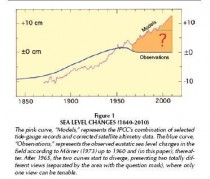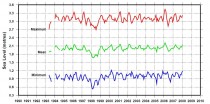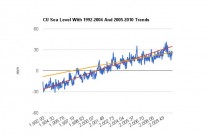By Paula Scully
UPDATE: See these two important reports on sea level, one by Nils Axel Morner, this part I of a an excellent two part study by John Droz.

Enlarged. Morner shows how the trend is almost entirely due to unwarranted “adjustments” much like we find with global temperatures.
------------
While the economy may be the most immediate issue, climate change is on our doorstep, said Melanie Reding, education coordinator for the Jacques Cousteau Coastal Education Center in Little Egg Harbor.
Reding spoke Saturday about sea level rise and what warming oceans mean for New Jersey’s coast, to an audience at the Long Beach Island Foundation of the Arts and Sciences.
“New Jersey has a real issue,” Reding said. “Sixty percent of our population lives within the coastal region. We have low elevation and high population.” The sea level at Atlantic City has risen about 14 inches since records began in 1912, half because of the rise in sea level and the other half to subsidence - sinking of the land.
Reding cited an article reporting that 97 of 100 climate experts say humans are changing global temperatures. The article, “Examining the Scientific Consensus on Climate Change” by P. Doran and M. Zimmerman, was published in 2009 in Eos, Transactions, American Geophysical Union. “From the media, you’d think there is a debate,” she said. While public opinion remains divided, climatologists agree that climate change has accelerated, she said.
ICECAP NOTE: First that 97% number study which was even used in congress by Waxman and others is not what it seems and does not as Reding claim reflect the opinion of 97 of every 100 scientists that the global warming science is solid and settled.
The number stems from a 2009 online survey of 10,257 earth scientists, conducted by two researchers at the University of Illinois of whom 3,146 responded, less than a 31% response rate. Of that number, only 5% described themselves as climate scientists, numbering 157. The authors reduce that by half by only counting those who they classed as “specialists”. So the researchers used just 79 respondees for their report. Not exactly a survey of the ‘worlds climate scientists’.
Of these specialists, 96.2% (76 of 79) answered “risen” to question 1 and 97.4% (75 of 77) answered yes to question 2. The two questions were worded such that any climate scientist pro man-made or those who believe natural factors dominate would have responded yes.
The first question asked whether the earth has warmed since before 1800. Since before 1800, the earth was in the Little Ice Age, it would have been unreasonable to respond no. The second asked whether man has been responsible for warming. Since 30-50% of the observed warming has been shown by dozens of peer review papers to be the result of urbanization and land use changes, even those of us who believe the rest is primarily due to ocean and solar cycles, would have answered yes. The Scientific American on-line poll of scientifically literate readers, recently pulled, was probably closer to the truth. With a total of 5190 respondents, a consensus of 81.3% think the IPCC is “a corrupt organization, prone to group-think, with a political agenda” and 75% think climate change is caused by solar variation or natural processes vs. 21% who think it is due to greenhouse gases from human activity.
As for sea level rises, Holgate (2007) has shown a deceleration below the lowest rate of the range specified by the IPCC.
The islands of the Pacific are claimed to be the most threatened with rising sea levels by the IPCC.
Dr. Cliff Ollier reviews sea level rise for “Tuvalu, the favourite island to be doomed by sea level rise driven by global warming, allegedly caused by anthropogenic carbon dioxide. If you look up Tuvalu on the internet you are inundated with articles about its impending fate. Tuvalu has become the touchstone for alarm about global warming and rising sea level. He shows the data from the Australian BOM shows no changes for 20 years.”
More generally, Dr. Vincent Gray in this analysis wrote:
“The SEAFRAME sea-level study on 12 Pacific Islands is the most comprehensive study of sea level and local climate ever carried out there. The sea level records obtained have all been assessed by the anonymous authors of the official reports as indicating positive trends in sea level over all 12 Pacific Islands involved since the study began in 1993 until the latest report in June 2010. In almost all cases the positive upward trends depend almost exclusively on the depression of the ocean in 1997 and 1998 caused by two tropical cyclones. If these and other similar disturbances are ignored, almost all of the islands have shown negligible change in sea level from 1993 to 2010, particularly after the installation of GPS leveling equipment in 2000.”
Gray notes that the claimed trends of 3.7 to 9.2 mm/year do not match the measured trends which are zero for up to 18 years.
See again here how sea level rises have actually slowed in recent years (source NOAA lab at UCO) with a only a brief pop with the El Nino of 2009/10 as oceans briefly expanded with the El Nino warmth).
To her credit, Reding did acknowledge that subsidence of the land was responsible for part of the sea level rise. In most places where the sea level rises are larger than average subsidence is a key issue.
Today this from Bob Carter is more peer review evidence that sea levels are not accelerating.
An important new paper, which confirms again that no sea-level acceleration can be detected (thanks to Willem and John Droz, who forwarded it).
HOUSTON, J.R. and DEAN, R.G., 0000. Sea-level acceleration based on U.S. tide gauges and extensions of previous global-gauge analyses. Journal of Coastal Research, 00(0), 000–000. West Palm Beach (Florida), ISSN 0749-0208.
Without sea-level acceleration, the 20th-century sea-level trend of 1.7 mm/y would produce a rise of only approximately 0.15 m from 2010 to 2100; therefore, sea-level acceleration is a critical component of projected sea-level rise. To determine this acceleration, we analyze monthly-averaged records for 57 U.S. tide gauges in the Permanent Service for Mean Sea Level (PSMSL) data base that have lengths of 60-156 years. Least-squares quadratic analysis of each of the 57 records are performed to quantify accelerations, and 25 gauge records having data spanning from 1930 to 2010 are analyzed. In both cases we obtain small average sea-level decelerations. To compare these results with worldwide data, we extend the analysis of Douglas (1992) by an additional 25 years and analyze revised data of Church and White (2006) from 1930 to 2007 and also obtain small sea-level decelerations similar to those we obtain from U.S. gauge records.






